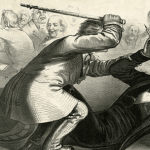 Miscellaneous
Miscellaneous  Miscellaneous
Miscellaneous  History
History 10 Huge Historical Events That Happened on Christmas Eve
 Music
Music 10 Surprising Origin Stories of Your Favorite Holiday Songs
 History
History 10 Less Than Jolly Events That Occurred on December 25
 Weird Stuff
Weird Stuff 10 Funny Ways That Researchers Overthink Christmas
 Politics
Politics 10 Political Scandals That Sent Crowds Into the Streets
 Weird Stuff
Weird Stuff Ten Bizarre Facts About The Doge Meme
 Our World
Our World 10 Ways Your Christmas Tree Is More Lit Than You Think
 Movies and TV
Movies and TV The 10 Coolest Stars to Set Sail on The Love Boat
 History
History 10 Things You Didn’t Know About the American National Anthem
 Miscellaneous
Miscellaneous Top 10 Things Crypto Was Supposed to Change & What Actually Did
 History
History 10 Huge Historical Events That Happened on Christmas Eve
 Music
Music 10 Surprising Origin Stories of Your Favorite Holiday Songs
Who's Behind Listverse?

Jamie Frater
Head Editor
Jamie founded Listverse due to an insatiable desire to share fascinating, obscure, and bizarre facts. He has been a guest speaker on numerous national radio and television stations and is a five time published author.
More About Us History
History 10 Less Than Jolly Events That Occurred on December 25
 Weird Stuff
Weird Stuff 10 Funny Ways That Researchers Overthink Christmas
 Politics
Politics 10 Political Scandals That Sent Crowds Into the Streets
 Weird Stuff
Weird Stuff Ten Bizarre Facts About The Doge Meme
 Our World
Our World 10 Ways Your Christmas Tree Is More Lit Than You Think
 Movies and TV
Movies and TV The 10 Coolest Stars to Set Sail on The Love Boat
 History
History 10 Things You Didn’t Know About the American National Anthem
History’s Ten Most Intense Sibling Feuds
Brotherly love may be an ideal to strive for in your life, but it’s not always what comes out when the going gets tough. While many families tend to close ranks and help each other in business and life, some decide to duke it out instead. Sibling feuds can be more vicious and long-standing than nearly any other feud there is. The stakes are high, the blood runs hot, and the fight never ends—not when it comes against the person you grew up with!
In this list, we’ll look at ten wild, crazy, and long-lasting sibling feuds. These siblings held considerable positions of power and/or influence, but they still couldn’t overcome one thing: their hatred of each other. In these stories, you’ll hear tales of people who spent years vindictively trying to keep their brother or sister from rising higher than them. These stories are so wild that they’ll make you want to go call your siblings right away and tell ’em that you love them!
Related: 10 Brutal Family Battles for the Throne
10 Tommy and Jimmy Dorsey
Tommy and Jimmy Dorsey were brothers who blew up big as musicians during the jazz and swing eras of the 1930s and 1940s. Jimmy played the clarinet and the saxophone. Tommy played the trumpet and the trombone. And they hated each other! It didn’t start out that way, though.
In 1933, they formed their own band, The Dorsey Brothers. They played to adoring fans all over the country like that. But other bandmates couldn’t help but notice a rift grow between the brothers. Over time, they started fighting viciously with each other—about anything and everything. They would fight about the music, too. The tempo of the songs, the musical decisions being made between them, the style they wanted to record in, and even where and when they performed live shows. They fought around the clock, other bandmates recalled in a not-so-fond way years later.
They were so notorious for their vicious fights that it was a regular thing for them to break each others’ musical instruments. Jimmy would snatch Tommy’s trombone and step on it, then Tommy would yank away Jimmy’s saxophone and smash it on the floor. Talk about a blood feud! What did those instruments ever do to them?!
After more than two years of that, in 1935, Tommy walked away from the band for good. Interestingly, both brothers turned out to have monumentally successful solo careers. Each of their assembled orchestras produced major hits throughout the 1940s. But they still stayed mad at each other throughout the decade. Finally, in 1953, they reunited as two members of the in-house band for Jackie Gleason’s “Stage Show” bandstand variety act. It was just in time, too, because Tommy passed away three years later, in 1956, and Jimmy went one year after that.[1]
9 Prince John and King Richard
Many siblings have fought over the right to rule a nation. And Richard and John, the sons of King Henry II, were certainly no exception. In fact, their rivalry was pretty much one of the most intense ever. Richard was born in 1157, and John came around nine years later, in 1166. With Richard as the eldest son of Henry, he was expected to take on the dynasty.
Unfortunately for John, being fourth-born, he was pretty much passed over for any role in the family dynasty. He didn’t care for that much, but his father thought little of him. King Henry even went so far as to nickname John “Lackland,” accounting for his lacking abilities. Ouch! And then, fate stepped in. Middle brothers Geoffrey and Henry the Younger both died prematurely. Soon after that, King Henry’s relationship with Richard started to falter. And suddenly, John was an important part of Henry’s plans for who would succeed him on the throne.
However, King Henry, ever the rascal, began to play the brothers off each other. He wanted to keep John in the loop and keep Richard uncertain about his place in line for the throne after assuming for so long that he’d have it locked up after King Henry departed. That backfired, though. Richard and Henry ended up allying against their father before his passing. However, after Richard became king in 1189, he wanted to do one thing: ship his younger brother away from England for three years.
His mother convinced him not to do it, and then Richard left to join the Third Crusade. With John hanging around at home, John conspired against Richard’s regent back in England and wound up taking immense power over the kingdom. John even tried to conspire with the king of France, Philip Augustus, to help him take the throne for himself. That plot failed, and Richard returned to chaos. Incredibly, though, King Richard—known as the “Lionheart” in his day—eventually forgave his brother for the intense feud. We’re not sure that we could be that generous…[2]
8 King Louis XIV and Philippe I
There are so many sibling rivalries among royal heirs that we couldn’t possibly cover them all in this list. But there is at least one more notable one worth discussing: France’s King Louis XIV and his brother, Philippe I, the eventual Duke of Orléans. Philippe was born in 1640 as the second son of King Louis XIII, so he didn’t stand to inherit the throne ahead of his older brother.
There was just one problem with that: Louis XIV, who came to be known during his reign as the Sun King, was not a natural-born ruler. Philippe, on the other hand, was. He was extremely intelligent, charismatic, outgoing, and even remarkably attractive by the day’s standards. All those things would have made him a great ruler, too!
Philippe had another side to his life, too, though. He enjoyed physical relationships with men, which was still frowned upon then, and he often dressed in women’s clothes. Some sources even claim King Louis XIII purposely dressed him as such from a young age to socialize him into a more feminine lifestyle, hoping he would not want to take over power from his older brother.
Regardless, Philippe’s talents were too great to ignore. As a lieutenant general, his shrewd planning won the critical Battle of Cassel for his kingdom. And then, he disappeared. Not totally, mind you. But Louis XIV saw how talented Philippe was, how much of a threat he posed to the monarchy, and the possibility of overtaking his older brother. Thus, the Sun King banned him from future military endeavors.
He also made sure that Philippe held no political power or sway within France while he was ruling the nation—which the Sun King did for seven decades, the longest reign in Europe. Poor Philippe; talented enough to be king, but shut out of the system by the customs of familial hierarchy and the scheming of his older brother.[3]
7 Leo and Ron Gallagher
Leo Gallagher is very famous across the entire comedy world for being the guy who smashes watermelons on stage. He’s been doing it for years—decades, actually! But back in the 1990s, his brother got in the act. And by “got in the act,” we mean Leo’s younger brother Ron Gallagher completely stole his shtick and started destroying fruit with sledgehammers for comedy audiences all across the country.
It all started after Leo first found success as a prop comic in the early 1990s. Not long after that, Ron—who was unemployed—asked Leo for permission to tour around to smaller nightclubs and comedy outlets with the same routine. Leo said that would be fine, so long as Ron made it clear that the two brothers’ acts were different, and Ron was NOT to perform under the single name “Gallagher.” Sadly, that didn’t happen.
Ron’s promotional materials didn’t make it very clear that he wasn’t the “real” Gallagher brother smashing fruit. Ron also made himself look pretty much identical to his older brother and copied his act nearly down to the second. Ron himself was very open about that, too, once boasting to the media that most of the people who saw his show assumed they had seen the real (and, as far as they knew, the only) Gallagher brother on stage.
Leo hated all that more than anything in the world. At one point, accusing his brother of straight-up copying his act, Leo actually sued him in court for trademark infringement! And not only that, but it grew into a massive blood feud between the brothers. It seems the two of them didn’t speak to each other for more than two decades. Ouch![4]
6 Oda Nobunaga and Oda Nobuyuki
In the 16th century in Japan, there was a notorious and impressive warlord named Oda Nobunaga. Unfortunately for him, he had a vicious feud with his brother, Oda Nobuyuki, which went all the way back to childhood. See, Nobunaga was the second son of their father, a man named Oda Nobuhide.
However, he was technically the heir to Nobuhide because the man’s first son was illegitimate. The only problem was that Nobuhide actually preferred his eldest (illegitimate) child more than any other son he had. To make matters worse, Nobunaga became openly disrespectful of his father and Japan’s paternal traditions, creating an even bigger rift.
Where does the younger brother Nobuyuki come into play, you ask? Well, after Nobuhide died in 1551, the Oda clan split into several different factions. One major faction showed their loyalty to the younger brother, Nobuyuki, who was more soft-spoken and respectful of tradition. Five years later, Nobuyuki decided to strike by leading a violent rebellion against his older brother’s interests. Nobunaga eventually put down the rebellion and even decided to pardon his brother after a while. But the damage was done.
In 1557, Nobuyuki again tried to rebel against his ungrateful older brother. This time, Nobunaga finally decided to get rid of him once and for all to ensure he wouldn’t cause any more problems. To do that, Nobunaga faked a sickness, prompting his brother to come to visit. When Nobuyuki arrived, Nobunaga had him murdered.
It all ended well, though; the murder led to Nobunaga uniting all of Owari Province, which in turn allowed him to become a viciously feudal warlord and, in time, pushed all of Japan to unite. And to think it all started with a brotherly feud![5]
5 Commodus and Lucilla
Roman rulers were historically chosen by merit and/or political advantage before Commodus ascended to the top spot in AD 176. He was the first major ruler chosen by birthright in that empire, and to say that choice was most likely a mistake is, uh, putting it lightly.
He inherited the throne from his father, Marcus Aurelius. And for many people, that was a very controversial decision. But it was the most controversial choice with Commodus’s very own sister, Lucilla. She was married to Lucius Verus, who was Aurelius’s right-hand man during the late ruler’s life, and he had been expecting to become the heir to the Roman leadership after Marcus’s death.
But once Commodus ascended to the top, all hell broke loose. Lucilla began to plot with some Roman senators to have her brother assassinated. A first assassination attempt failed, though. In response, Commodus exiled his sister and her daughter to the island of Capri.
But it wasn’t long before Commodus had a bit of a change of heart. He came to realize that his sister was too dangerous while still alive. So, he had both Lucilla and her daughter murdered just in case they were to ever try to take the throne from him again. Talk about a vicious end to a fiery sibling rivalry![6]
4 Rudolf and Adolf Dassler
The Puma and Adidas sportswear companies we know today started under a pair of German brothers, Rudolf “Rudi” Dassler and Adolf “Adi” Dassler. Rudi was drafted to fight for the Germans during World War I. Meanwhile, Adi used his youth to begin creating shoes in their family home. After Rudi returned from the war, the two created the Dassler Brothers Sports Shoe Company. And it was a massive success!
At the Berlin Olympics in 1936, American sprinter Jesse Owens won four gold medals while wearing their shoes. Cool, right? A great success story with two brothers riding high?! Well… when World War II hit, rifts began to show. First, Rudi refused to employ his sister Marie’s two sons in the company, wanting to keep control of the company for himself. Marie was mad at the decision. And she became even more angry when her sons were both drafted into the Nazi army and killed in battle.
Rudi himself was later drafted in 1943—a move for which he blamed his brother, Adi. He felt that Adi was secretly trying to take over the entire company and wanted Rudi away for that to happen. Rudi even tried to desert his military post at one point, but he was caught by the Gestapo and imprisoned for the rest of the war.
After the war ended and the Nazis lost, the feuding brothers subtly tried to paint one or the other of them as the most loyal former Nazi party member. Eventually, they split off their assets into two companies. The feuding got so bad that they couldn’t go on together.
So, in 1948, Adi formed “Adidas,” using a shortened version of his first and last name. And Rudi formed a company called “Ruda,” which eventually became the brand “Puma.” Both companies became massively successful on a worldwide scale. The feud persisted, though. On his deathbed in 1974, Rudi asked if Adi would come to see him… and Adi declined. Ouch.[7]
3 Joan Fontaine and Olivia de Havilland
Old Hollywood actresses Joan Fontaine and Olivia de Havilland were born just 15 months apart. And ever since they could walk and talk, long before they became famous stars, their feud began. Joan thought Olivia (the older sister) was their mother’s favorite child. That led to arguments that often became violent, and the two fought viciously for years.
In one ugly incident, Olivia threw Joan down during a fight and fractured her collarbone. Ouch! Then, in high school, when Olivia became editor of the school magazine, she published a mock will in one issue that sarcastically ripped into her younger sister: “I bequeath to my sister the ability to win boys’ hearts, which she does not have at present.”
As the two women rose to become celebrities, Olivia encouraged Joan not to use the family name for herself. The two sisters worked at different studios, and for a long time, they battled it out in auditions for various film roles. The culmination was in 1942 when Olivia was up for an Academy Award for her work in the movie Hold Back the Dawn. Joan was nominated that same year for her role in Suspicion, a movie co-starring Cary Grant and directed by Alfred Hitchcock. Joan, the massive underdog, won. And then she snubbed her sister in her acceptance speech!
By 1947, Olivia was married to novelist Marcus Goodrich, and Joan was shading her to the utmost degree. When asked about her sister’s new husband, Fontaine said: “All I know about him is that he’s had four wives and written one book. Too bad it’s not the other way around.” Tragedy struck in 1975 when the sisters’ mother passed away from cancer. Joan claimed Olivia didn’t invite her to the funeral—even though she showed up anyway.
Then, while promoting her memoir in 1978, Fontaine reflected on her horrible relationship with De Havilland: “You can divorce your sister as well as your husbands. I don’t see her at all, and I don’t intend to… Olivia has always said I was first at everything—I got married first, got an Academy Award first, and had a child first. If I die, she’ll be furious because, again, I’ll have got there first!” Joan did indeed die first, passing away in 2013. The feud simmered until her very last day.[8]
2 Noel and Liam Gallagher
The feud between Oasis bandmates and brothers Noel and Liam Gallagher may be the most notable one on this list—and that’s really saying something. The two brothers fought like cats and dogs pretty much from birth. But when Oasis began to become popular in America in 1994, their feud kicked into high gear.
During a set that year in Los Angeles, Liam infamously hit Noel in the head with a tambourine on stage. Noel quit the band the following day, only to return soon after that. Not long after, Liam ditched the band’s MTV Unplugged performance. He claimed to have had laryngitis. There was just one problem with that: he showed up in the audience, chain-smoked cigarettes, and heckled his brother on stage.
Liam then skipped an entire American tour because he said that he was house-hunting with his fiancée. Noel was so mad that he did the same thing a few weeks later, ditching the tour and avoiding his brother. Their worst fight, no doubt, came in 2000 when Liam publicly questioned whether Noel was actually the biological father of his child.
That prompted Noel to (temporarily) quit the band again. And then Noel gave it up for good in 2009, walking away from Oasis forever. That hasn’t stopped Liam from taking shots at him, though. To this day, Liam still whines about his brother on X/Twitter.[9]
1 Ann Landers and Dear Abby
It’s hard to believe now, but there used to be such a thing as newspaper advice columnists. And the two most famous of those were the women who wrote “Ask Ann Landers” and “Dear Abby.” In fact, they were actually very close twin sisters. That is, until a feud viciously ripped them apart from each other!
Born on July 4, 1918, in Sioux City, Iowa, Esther “Eppie” Friedman and her sister Pauline Friedman were super-close identical twins. That all changed in 1956, though, when Esther took a job writing the “Ask Ann Landers” newspaper column. Pauline had moved to San Francisco that year, and she went into a newspaper in that city and told them she could write a better advice column than their current writer. Editors were wowed by her way with words and gave her the gig. Pauline took the pen name Abigail Van Buren, and just like that, “Dear Abby” was born.
Inevitably, that led to major conflict. Pauline pushed the sisters’ hometown newspaper to syndicate her column—so long as they didn’t print her sister’s work. As to be expected, that pissed Esther off. The sisters didn’t speak to each other for nearly a decade after that. They briefly reconciled in 1964, but then the feud started up again. That time, they iced each other out until just before Esther died in 2002.
Amazingly, the feud continued over to the next generation. Esther’s daughter, Margo Howard, publicly slammed Pauline’s daughter, Jeanne Phillips, after the two sisters had passed away for taking over the “Dear Abby” column and publishing a farewell letter to her aunt (Margo’s mother). Margo said the letter was “self-serving and loopy” and made even worse because Jeanne apparently didn’t even have a relationship with her aunt. The fighting never ends![10]








